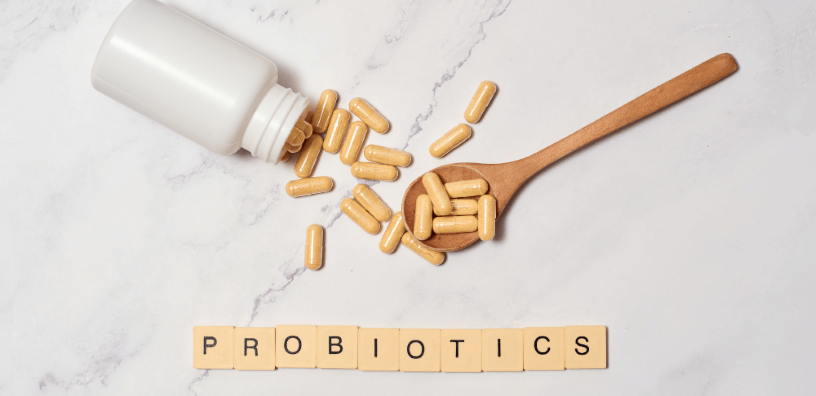New Year, New… Gut?
We’re claiming that 2023 is the year of probiotics! Why you ask? Well… Did you know that your gut health is directly linked to other parts of your health?
While your diet and lifestyle habits can play a role in your gut health, sometimes we just need a little help. That’s where probiotics come in.
Keep reading to get to know your gut and why you should consider implementing probiotics to your daily supplement regimen.

Get to Know Your Gut
First things first, let’s get to know all about the bacteria in your gut. Yes—bacteria.
Bacteria, viruses, fungi, and other microscopic living things exist inside your intestines and on your skin. All of these things are referred to as microorganisms or microbes. A fascinating fact is that you have more bacterial cells in your body than human cells—You have roughly 40 trillion bacterial cells in your body versus only 30 trillion human cells.[1,2]
The microbes found in your intestines are referred to as the gut microbiome or gut flora. Everyone has nearly 200 different species of microbes in their digestive tract.[3] And while some are harmful to your health, there are many that are beneficial and necessary for your health.[4]
Your gut flora performs many functions that impact your health. It makes vitamins, including vitamin K and a few B vitamins.
Additionally, it turns fibers into short-chain fats that feed your gut wall and plays a role in metabolic functions, stimulate your immune system, and improve your gut wall.[5,6,7,8,9]
Unfortunately, your gut flora is extremely sensitive and, when unbalanced, can lead to a handful of health issues.[10,11]
That’s where probiotics come in. They help correct this balance and help your gut flora to function properly.[12]

What are Probiotics?
Probiotics are live microorganisms that can provide numerous health benefits when consumed. Many of these microorganisms in probiotics are about the same that naturally live in your body.
You can find probiotics in fermented foods, like yogurt, or dietary supplements.
And probiotics have become increasingly popular over the years. One survey found that 4 million (1.6 percent) of U.S. adults had used probiotics in the past month. Additionally, probiotics were the third most used supplement other than vitamins and minerals.[13]
Types of Bacteria in Probiotics
There are a lot of different types of bacteria strains. However, there are two in particular that are common when it comes to probiotic supplements: Lactobacillus and Bifidobacterium. Additionally, some probiotics contain yeasts such as Saccharomyces boulardii.

Benefits of Taking Probiotics
There are numerous benefits of taking probiotics. Here are just a few:
Maintains Digestive Balance
Probiotics have been shown to help alleviate gut health issues like constipation, diarrhea, and stomach irritation by balancing gut flora.[14,15,16,17]
Improves Immune Health
Research has shown that probiotics’ proprietary blends can help reduce levels of harmful gut bacteria to promote immune function.[14,16,18]
Gut-Brain Axis
Your gut and brain are surprisingly connected. Probiotics, especially ones with strains Lactobacillus helveticus and Bifidobacterium longum, can help boost your mood and cognitive function, as well as help lower symptoms of stress and anxiety.[19,20]
Inflammation
Probiotics can help reduce systemic inflammation, which is a cause of many diseases.[21]
Skin Health
While research is limited, probiotics have been shown to help with skin disorders such as rosacea, eczema, acne, and more.[22]

What to Look For in a Probiotic
It’s easy to get overwhelmed when searching for the right supplements for you—there are so many options out there. Here are a few things to keep in mind when shopping for probiotics:
Hight Count of CFUs (Colony Forming Units)
CFU refers to the amount of live and active microorganisms found in each serving. The microorganisms will begin to colonize the good bacteria in your digestive tract, hence the name. The amount of CFUs can play a role in how effective the probiotic is.
While millions sound like a lot, you want a probiotic that has a dose that contains organisms in the billions. To achieve optimum immune and digestive health benefits that probiotics can provide, make sure you have the correct amount of a proven strain.
Pure Ingredients
Supplements should give you only what you need and nothing that you don’t. Look for supplements that have pure, simple ingredients — the less on the label, the better. It ensures you are getting all the benefits that probiotics have to offer.
Naturally Sourced Strains
Diversity is your friend. Multi-strain mixtures benefit you and your health since there is a broader range of effects and more mechanisms of action.[23]
Find a probiotic with naturally sourced strains, that are certified vegan, non-GMO, and are free of gluten, dairy, and soy.
Delayed-Release
Delayed-release capsules help ensure the supplement is protected from harsh stomach acid and released in the intestines for maximum nutrient absorption.
Made in the USA
Regulations on probiotics vary around the world. Therefore, ordering online from other countries can be risky. To be safe, we recommend only buying probiotics from US-based brands that you trust.

Our Pick
Our very own Pattern Wellness Probiotic checks all the boxes.
Our Probiotic offers an incredible value featuring 51 billion colony-forming units from 11 naturally-sourced probiotic strains, which are packed with many healthful benefits. This certified hormone-free, non-GMO supplement is free of gluten, dairy, and soy, making it a formula you can trust.
Delayed-release capsules help ensure the supplement is protected from harsh stomach acid and released in the intestines for maximum nutrient absorption.
Ready to try it out for yourself? Click here!
Resources:
- Qin, J., Li, R., Raes, J., Arumugam, M., Burgdorf, K. S., Manichanh, C., Nielsen, T., Pons, N., Levenez, F., Yamada, T., Mende, D. R., Li, J., Xu, J., Li, S., Li, D., Cao, J., Wang, B., Liang, H., Zheng, H., Xie, Y., … Wang, J. (2010). A human gut microbial gene catalogue established by metagenomic sequencing. Nature, 464(7285), 59–65. https://doi.org/10.1038/nature08821
- Sender, R., Fuchs, S., & Milo, R. (2016). Revised Estimates for the Number of Human and Bacteria Cells in the Body. PLoS biology, 14(8), e1002533. https://doi.org/10.1371/journal.pbio.1002533
- Hills, R. D., Jr, Pontefract, B. A., Mishcon, H. R., Black, C. A., Sutton, S. C., & Theberge, C. R. (2019). Gut Microbiome: Profound Implications for Diet and Disease. Nutrients, 11(7), 1613. https://doi.org/10.3390/nu11071613
- Valdes, A. M., Walter, J., Segal, E., & Spector, T. D. (2018). Role of the gut microbiota in nutrition and health. BMJ (Clinical research ed.), 361, k2179. https://doi.org/10.1136/bmj.k2179
- Rowland, I., Gibson, G., Heinken, A. et al. Gut microbiota functions: metabolism of nutrients and other food components. Eur J Nutr 57, 1–24 (2018). https://doi.org/10.1007/s00394-017-1445-8
- Natarajan, N., & Pluznick, J. L. (2014). From microbe to man: the role of microbial short chain fatty acid metabolites in host cell biology. American journal of physiology. Cell physiology, 307(11), C979–C985. https://doi.org/10.1152/ajpcell.00228.2014
- Kim, C. H., Park, J., & Kim, M. (2014). Gut microbiota-derived short-chain Fatty acids, T cells, and inflammation. Immune network, 14(6), 277–288. https://doi.org/10.4110/in.2014.14.6.277
- Lei, Y. M., Nair, L., & Alegre, M. L. (2015). The interplay between the intestinal microbiota and the immune system. Clinics and research in hepatology and gastroenterology, 39(1), 9–19. https://doi.org/10.1016/j.clinre.2014.10.008
- Caricilli, A. M., Castoldi, A., & Câmara, N. O. (2014). Intestinal barrier: A gentlemen's agreement between microbiota and immunity. World journal of gastrointestinal pathophysiology, 5(1), 18–32. https://doi.org/10.4291/wjgp.v5.i1.18
- Bull, M. J., & Plummer, N. T. (2014). Part 1: The Human Gut Microbiome in Health and Disease. Integrative medicine (Encinitas, Calif.), 13(6), 17–22.
- Zhang, Y.-J., Li, S., Gan, R.-Y., Zhou, T., Xu, D.-P., & Li, H.-B. (2015). Impacts of Gut Bacteria on Human Health and Diseases. International Journal of Molecular Sciences, 16(12), 7493–7519. https://doi.org/10.3390/ijms16047493
- Shah, B. R., Li, B., Al Sabbah, H., Xu, W., & Mráz, J. (2020). Effects of prebiotic dietary fibers and probiotics on human health: With special focus on recent advancement in their encapsulated formulations. Trends in Food Science & Technology, 102, 178–192. https://doi.org/10.1016/j.tifs.2020.06.010
- U.S. Department of Health and Human Services. (n.d.). Probiotics: What you need to know. National Center for Complementary and Integrative Health. Retrieved November 11, 2022, from https://www.nccih.nih.gov/health/probiotics-what-you-need-to-know
- Kim, S. K., Guevarra, R. B., Kim, Y. T., Kwon, J., Kim, H., Cho, J. H., Kim, H. B., & Lee, J. H. (2019). Role of Probiotics in Human Gut Microbiome-Associated Diseases. Journal of microbiology and biotechnology, 29(9), 1335–1340. https://doi.org/10.4014/jmb.1906.06064
- Wieërs, G., Belkhir, L., Enaud, R., Leclercq, S., Philippart de Foy, J. M., Dequenne, I., de Timary, P., & Cani, P. D. (2020). How Probiotics Affect the Microbiota. Frontiers in cellular and infection microbiology, 9, 454. https://doi.org/10.3389/fcimb.2019.00454
- Wilkins, T., & Sequoia, J. (2017). Probiotics for Gastrointestinal Conditions: A Summary of the Evidence. American family physician, 96(3), 170–178.
- Zhang, C., Derrien, M., Levenez, F., Brazeilles, R., Ballal, S. A., Kim, J., Degivry, M. C., Quéré, G., Garault, P., van Hylckama Vlieg, J. E., Garrett, W. S., Doré, J., & Veiga, P. (2016). Ecological robustness of the gut microbiota in response to ingestion of transient food-borne microbes. The ISME journal, 10(9), 2235–2245. https://doi.org/10.1038/ismej.2016.13
- Singh, V. P., Sharma, J., Babu, S., Rizwanulla, & Singla, A. (2013). Role of probiotics in health and disease: a review. JPMA. The Journal of the Pakistan Medical Association, 63(2), 253–257.
- Mörkl, Sabrina et al. “Probiotics and the Microbiota-Gut-Brain Axis: Focus on Psychiatry.” Current nutrition reports vol. 9,3 (2020): 171-182. doi:10.1007/s13668-020-00313-5
- Luna, R. A., & Foster, J. A. (2015). Gut Brain Axis: Diet microbiota interactions and implications for modulation of anxiety and Depression. Current Opinion in Biotechnology, 32, 35–41. https://doi.org/10.1016/j.copbio.2014.10.007
- Lescheid, D. W. (2014). Probiotics as regulators of inflammation: A Review. Functional Foods in Health and Disease, 4(7), 299. https://doi.org/10.31989/ffhd.v4i7.2
- Lolou, V., & Panayiotidis, M. I. (2019). Functional Role of Probiotics and Prebiotics on Skin Health and Disease. Fermentation, 5(2), 41. https://doi.org/10.3390/fermentation5020041
- Chang, Hung-Yang, et al. “Multiple Strains Probiotics Appear to Be the Most Effective Probiotics in the Prevention of Necrotizing Enterocolitis and Mortality: An Updated Meta-Analysis.” PLOS ONE, vol. 12, no. 2, 2017, doi:10.1371/journal.pone.0171579.






Comments (0)